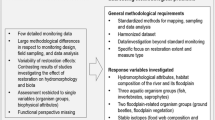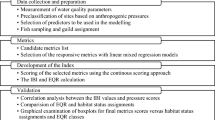Abstract
We propose a multi-level concept for fish-based assessment (MuLFA) of the ecological integrity of running waters. This concept is designed for large-scale monitoring programmes such as required for the proposed Water Framework Directive of the EU. Out of five different biological organisation levels (fauna, community, guild, population and individual), we propose seven criteria: River-type-specific species, species with self-sustaining populations, fish region, number of guilds, guild composition, population size and population age structure. The principle of the MuLFA is based on assessing the deviation from undisturbed reference conditions. Reference conditions have to be compiled for every distinct river type using historical fish and abiotic data, present river-type-specific reference sites and reference models. The final assessment procedure is done by comparing the assessment reach with the reference conditions using a 5-tiered normative scheme and assigning that reach to the level of highest coincidence. The benefit of the MuLFA is its potential for consistent sensitivity to low- and high-dose human alterations, and due to its general character, its adaptability to all river types.
Similar content being viewed by others
References
Adamicka, P., G. Bretschko, E. Danecker, J. Hinteregger, G. Imhof, M. Jungwirth, M. Leichtfried, O. Moog, C. Moritz, G. Müller, R. Pechlaner, E. Pipp, E. Polzer & N. Schulz, 1992. Zur Gewährleistung, Beeinträchtigung und Beurteilung der ökologischen Funktionsfähigkeit von Gewässern. Österreichs Fischerei 45: 120–121.
Allen, T. F. H. & T. B. Starr, 1982. Hierarchy: Perspectives for ecological complexity. University of Chicago Press, Chicago. 310 pp.
Amoros, C. & A. L. Roux, 1988. Interaction between water bodies within the flood plains of large rivers: Function and development of connectivity. In Schreiber, K. F. (ed.), Connectivity in Landscape Ecology. Münstersche Geographische Arbeiten: 125–130.
Angermeier, P. L. & J. R. Karr, 1986. Applying an index of biotic integrity based on stream-fish communities: considerations in sampling and interpretation. N. am. J. Fish. Manage. 6: 418–429.
Balon, E. K., 1975. Reproductive guilds of fishes: a proposal and definition. J. Fish. Res. Bd Can. 32: 821–864.
Balon, E. K., 1981. Additions and amendments to the classification of reproductive styles in fishes. Envir. Biol. Fishes 6: 377–389.
Baran, P., M. Delacoste, G. Poizat, J. M. Lascaux, S. Lek & A. Belaud, 1995. Multi-scales approach of the relationships between brown trout (Salmo trutta L.) populations and habitat features in the Central Pyrenees. Bull. fr. Peche Piscic. 337/338/339: 399–406.
Barnard, S. & R. J. Wyatt, 1995. An analysis of predictive models for stream salmonid population. Bull. fr. Peche Piscic. 337/338/339: 365–373.
Bayley, P. B. & H. W. Li, 1996. Riverine Fishes. In Petts, G. & P. Calow (eds), River Biota. Blackwell Science, Oxford: 92–122.
Binns, N. A. & F. M. Eiserman, 1979. Quantification of fluvial trout habitat in Wyoming. Trans. am. Fish. Soc. 108: 215–228.
Bowlby, J. N. & J. C. Roff, 1986. Trout biomass and habitat relationships in southern Ontario streams. Trans. am. Fish. Soc. 115: 503–514.
Dieplinger, K., S. Leberl & G. Zauner, 1996. Biotope management on the Austrian Danube. Arch. Hydrobiol. Suppl. 113, Large Rivers 10: 219–228.
Fausch, K. D., C. L. Hawkes & M. G. Parsons, 1988. Models that predict standing crop of stream fish from habitat variables: 1950–85. U.S. Forest Service General Technical Report PNW-GTR-213, Portland, OR. 52 pp.
Franklin, I. R., 1980. Evolutionary change in small populations. In Soulé, M. E. & B. A. Wilcox (eds), An Evolutionary-Ecological Perspecitve. Sinauer, Sunderland, Mass.: 135–149.
Frissell, C. A., W. J. Liss, C. E. Warren & M. D. Hurley, 1986. A hierarchical framework for stream habitat classification: viewing streams in a watershed context. Envir. Manage. 10: 199–214.
Habersack, H.M., 2000. The river scaling concept (RSC): a basis for ecological assessments. Hydrobiologia 422/423: 49–60.
Haidvogl, G. & H. Waidbacher, 1997. Ehemalige Fischfauna an ausgewählten österreichischen Fließgewässern. Abt. Hydrobiologie, BOKU, Wien. 85 pp.
Hughes, R. M., 1995. Defining acceptable biological status by comparing with reference conditions. In Davies, W. S. & T. P. Simon (eds), Biological Assessment and Criteria; Tools for Water Resource Planning and Decision Making. Lewis Publishers, Boca Raton, FL: 31–47.
Hughes, R. M. & R. F. Noss, 1992. Biological diversity and biological integrity: current concerns for lakes and streams. Fisheries 17: 11–19.
Hughes, R. M. & T. Oberdorff, 1998. Application of IBI concepts and metrics to waters outside the United States. In Simon, T. P. (ed.), Assessment Approaches for Estimating Biological Integrity using Fish Assemblages. Lewis Press, Boca Raton, FL: 79–83.
Illies, J., 1967. Limnofauna Europaea. Gustav Fischer Verlag. Stuttgart. 474 pp.
Illies, J. & L. Botosaneanu, 1963. Problèmes et méthodes de la classification et de la zonation écologique des eaux courantes considerées surtout du point de vue faunistique. Int. Verh. Limnol. 12: 1–57.
Jowett, I. G., 1992. Models of the abundance of large brown trout in New Zealand rivers. N. am. J. Fish. Manage. 12: 417–432.
Jungwirth, M., 1984. Die fischereilichen Verhältnisse in Laufstauen alpiner Flüsse, aufgezeigt am Beispiel der österreichischen Donau. Österreichische Wasserwirtschaft 36: 104–111.
Jungwirth, M., O. Moog, S. Schmutz & H. Wiesbauer, 1990. Gutachten Raum-und Umweltverträglichkeitsprüfung der Kraftwerksprojekte Obere Drau I Sachsenburg-Spittal-Mauthbrücken, Teilgutachten 4. Ökologie des aquatischen Lebensraumes, Hydrobiologie, BOKU, Wien.
Jungwirth, M., S. Schmutz & H. Waidbacher, 1989. Fischökologische Fallstudie Inn. Fischerei-Revierausschuß Innsbruck Stadt u. Land, Hall. 93 pp.
Jungwirth, M., S. Muhar & S. Schmutz, 1995. The effects of recreated instream and ecotone structures on the fish fauna of an epipotamal river. Hydrobiologia 303: 195–206.
Jungwirth, M., 1998. River Continuum and Fish Migration-Going Beyond the Longitudinal River Corridor in Understanding Ecological Integrity. In Jungwirth, M., S. Schmutz & S. Weiss (eds), Fish Migration and Fish Bypasses. Fishing News Books, Oxford: 19–32.
Jungwirth M., S. Muhar & S. Schmutz, 2000. Fundamentals of fish ecological integrity and their relation to the extended serial discontinuity concept. Hydrobiologia 422/423: 85–97.
Junk, W. J., P. B. Bayley & R. E. Sparks, 1989. The flood pulse concept in river-floodplain systems. Int. Riv. Symp. 106: 110–127.
Karr, J. R., 1981. Assessment of biotic integrity using fish communities. Fisheries 6: 21–27.
Kaufmann, T., S. Muhar, J. Raderbauer, O. Rathschüler, S. Schmutz, H. Waidbacher & G. Zauner, 1991. Fischökologische Studie Mur. Stadl bis Gratkorn, Hydrobiologie, BOKU, Wien. 104 pp.
Kryzhanovsky, S. G., 1948. Ecological groups of fishes and principles of their development. Naucho-Issled 27: 1–114.
Michel, P. & T. Oberdorff, 1995. Feeding habits of fourteen European freshwater fish species. Cybium 19: 5–46.
Miller, D. L., P. M. Leonard, R. M. Hughes, J. R. Karr, P. B. Moyle, L. H. Schrader, B. A. Thompson, R. A. Daniels, K. D. Fausch, G. A. Fitzhugh, J. R. Gammon, D. B. Halliwell, P. L. Angermeier & D. J. Orth, 1988. Regional applications of an index of biotic integrity for use in water resource management. Fisheries 13: 12–20.
Milner, N. J., R. J. Hemsworth & B. E. Jones, 1985. Habitat evaluation as a fisheries management tool. J. Fish. Biol. 27: 85–108.
Milner, N., R. Wyatt & M. Scott, 1993. Variability in the distribution and abundance of stream salmonids, and the associated use of habitat models. J. Fish. Biol. 43: 103–119.
Milner, N. J., R. J. Wyatt, S. Barnard & M. D. Scott, 1995. Variance structuring in stream salmonid populations, effects of geographical scale and implications for habitat models. Bull. fr. Peche Piscic. 337/338/339: 387–398.
Moog, O. & A. Chovanec, 2000. Assessing the ecological integrity of rivers: walking the line among ecological, political and administrative interests. Hydrobiologia 422/423: 99–109.
Muhar, S., 1996. Habitat improvement of Austrian rivers with regard to different scales. Reg. Riv. Res. Manage. 12: 471–482.
Muhar, S., A. Muhar, S. Schmutz, R. Wimmer, H. Wiesbauer, B. Hozang, G. Imhof & P. Tschemernig, 1993. Ausweisung naturnaher Fließgewässerabschnitte in Österreich, Vorstudie. Blaue Reihe BM Umwelt, Jugend u. Familie, Wien. 175 pp.
Muhar, S., S. Schmutz & M. Jungwirth, 1995. River restoration concepts-goals and perspective. Hydrobiologia 303: 183–194.
Muhar, S., M. Jungwirth, J. Eberstaller, C. Moritz, K. Michor, G. Egger & J. Petutschnig, 1998a. Der Zustand der Oberen Drau-Wertigkeiten und Defizite aquatischer und semi-/terrestrischer Zönosen. Österr. Wasser-und Abfallwirtschaft 50: 25–31.
Muhar, S., M. Kainz & M. Schwarz, 1998b. Ausweisung flußtypspezifisch erhaltener Fließgewässerabschnitte in Österreich, Teil 2. BMLF, Wien. 177 pp.
Muhar, S., M. Schwarz, S. Schmutz & M. Jungwirth, 2000. Identification of rivers with high and good habitat quality: methodological approach and applications in Austria. Hydrobiologia 422/423: 343–358.
Naiman, R. J., D. G. Lonzarich, T. J. Beechie & S. C. Ralph, 1992. General principles of classification and the assessment of conservation potential in rivers. In Boon, P. J., P. Calow & G. E. Petts (eds), River Conservation and Management. Wiley, Chichester: 95–125.
Noss, R. F., 1990. Indicators for monitoring biodiversity: a hierarchical approach. Conserv. Biol. 4: 355–364.
Oberdorff, T. & R. M. Hughes, 1992. Modification of an index of biotic integrity based on fish assemblages to characterize rivers of the Seine Basin, France. Hydrobiologia 228: 117–130.
Oberdorff, T. & J. P. Porcher, 1994. An index of biotic integrity to assess biological impacts of salmonid farm effluents on receiving waters. Aquaculture 119: 219–235.
Oberdorff, T., D. Pont, B. Hugueny, J. P. Porcher & D. Chessel (in press). A probabilistic model characterizing riverine fish communities of French rivers: a framework for the adaptation of a fish-based index. J. appl. Ecol.
Odum, E. P., 1971. Fundamentals of Ecology. Saunders, Philadelphia. 574 pp.
O'Neill, R. V., D. I. DeAngelis, J. B. Waide & T. F. H. Allen, 1986. A Hierarchical Concept of Ecosystems. Princeton University Press, Princeton, NJ. 253 pp.
Persat, H., J. M. Olivier & J. P. Bravard, 1995. Stream and Riparian Management of Large Braided Mid-European Rivers, and Consequences for Fish. World Fisheries Congress, New-Delhi, Oxford & IBH Publishing Co. Theme 1: 139–169.
Peter, A., 1998. Interruption of the river continuum by barriers and consequences for migratory fish. In Jungwirth, M., S. Schmutz & S. Weiss (eds), Fish Migration and Fish Bypasses. Fishing News Books, Oxford: 99–112.
Raleigh, R. F., L. D. Zuckerman & P. C. Nelson, 1984. Habitat suitability index models and instream flow suitability curves: brown trout. U.S. Fish and Wildlife Services Biological Services Program, FWS/OBS-82/10.71.
Scarnecchia, D. L. & E. P. Bergersen, 1987. Trout production and standing crop in Colorado's small streams, as related to environmental features. N. am. J. Fish. Manag. 7: 315–330.
Schiemer, F., M. Jungwirth & G. Imhof, 1994. Die Fische der Donau-Gefährdung und Schutz. Styria Medien Service, Graz.
Schiemer, F. & H. Waidbacher, 1992. Strategies for conservation of a Danubian fish fauna. In Boon, P. J., P. Calow & G. E. Petts (eds), River Conservation and Management. Wiley, Chichester: 363–382.
Schmutz, S. & M. Jungwirth, 1999. Fish as indicators of large river connectivity: the Danube and its tributaries. Arch. Hydrobiol. Suppl. 115/3: 329–348.
Stauffer, J. R., 1984. Colonization theory relative to introduced populations. In Courtenay, W. R. & J. R. Stauffer (eds), Distribution, Biology and Management of Exotic Fishes. Hopkins Univ. Press, Baltimore: 8–21.
Thienemann, A., 1926. Die Binnengewässer Mitteleuropas. Die Binnengewässer, Baud I. Schweizerbart'sche Verlagsbuchhandlung, Stuttgart.
Tockner, K. & F. Schiemer, 1997. Ecological aspects of the restoration strategy for a river-floodplain system on the Danube River in Austria. Glob. Ecol. Biogeo. Let. 6: 321–329.
Ward, J. V. & J. A. Stanford, 1995. Ecological connectivity in alluvial river ecosystems and its disruption by flow regulation. Reg. Riv. 11: 105–119.
Welcomme, R. L., 1984. International transfers of inland fish species. In Courtenay, W. R. & J. R. Stauffer (eds), Distribution, Biology, and Management of Exotic Fishes. Hopkins Univ. Press, Baltimore: 22–40.
Wesche, T. A., C. M. Goertler & W. A. Hubert, 1987. Modified habitat suitability index model for brown trout in southeastern Wyoming. N. am. J. Fish. Manage. 7: 232–237.
Zauner, G., 1993. Fischökologische Studie untere Thaya. Hydrobiologie, BOKU, Wien.
Zauner, G., 1994. Fischökologische Untersuchung, Teiluntersuchung 1.4.2 im Rahmen der Gesamtuntersuchung Salzach. Österreichisches Institut für Raumplanung, Wien. 135 pp.
Author information
Authors and Affiliations
Rights and permissions
About this article
Cite this article
Schmutz, S., Kaufmann, M., Vogel, B. et al. A multi-level concept for fish-based, river-type-specific assessment of ecological integrity. Hydrobiologia 422, 279–289 (2000). https://doi.org/10.1023/A:1017038820390
Issue Date:
DOI: https://doi.org/10.1023/A:1017038820390




